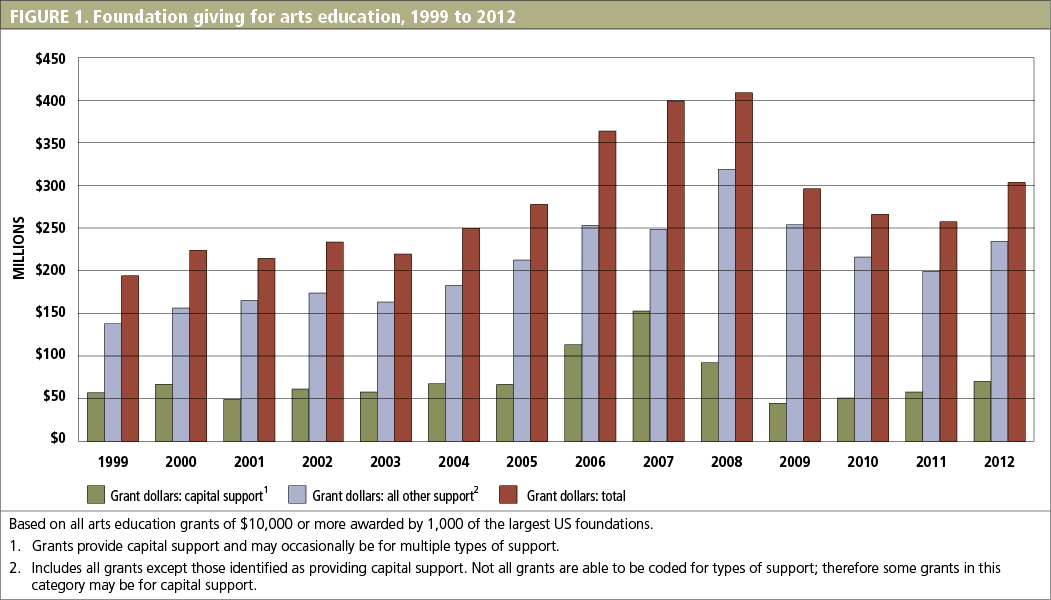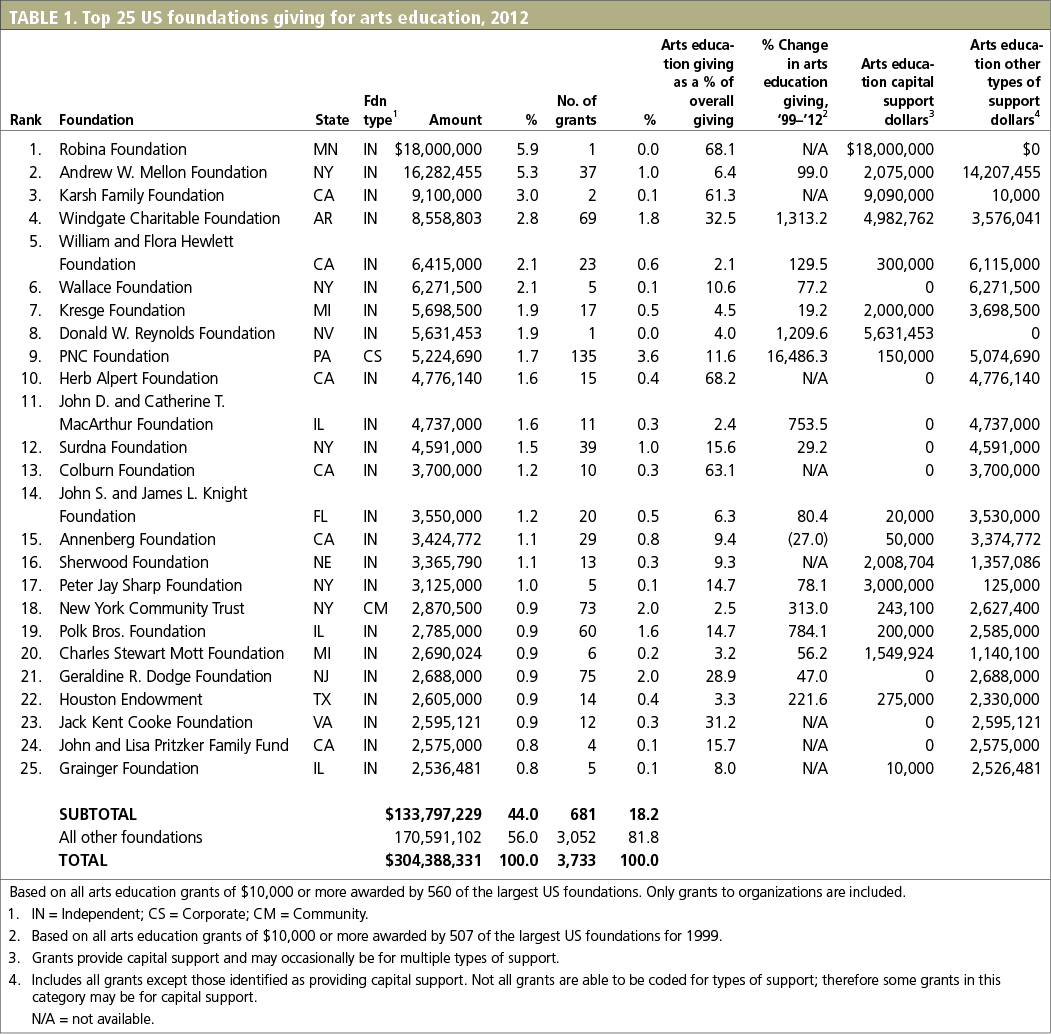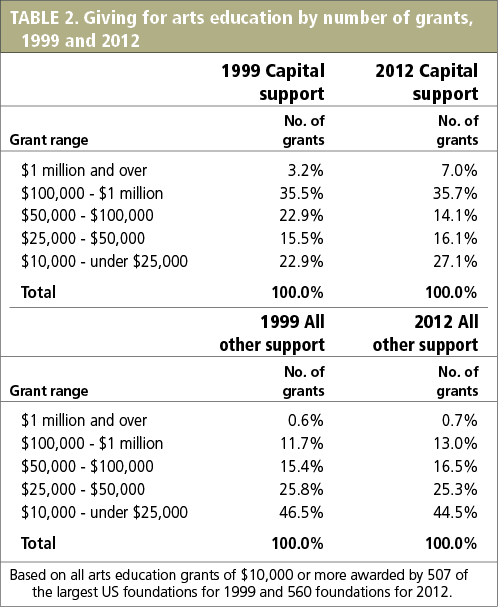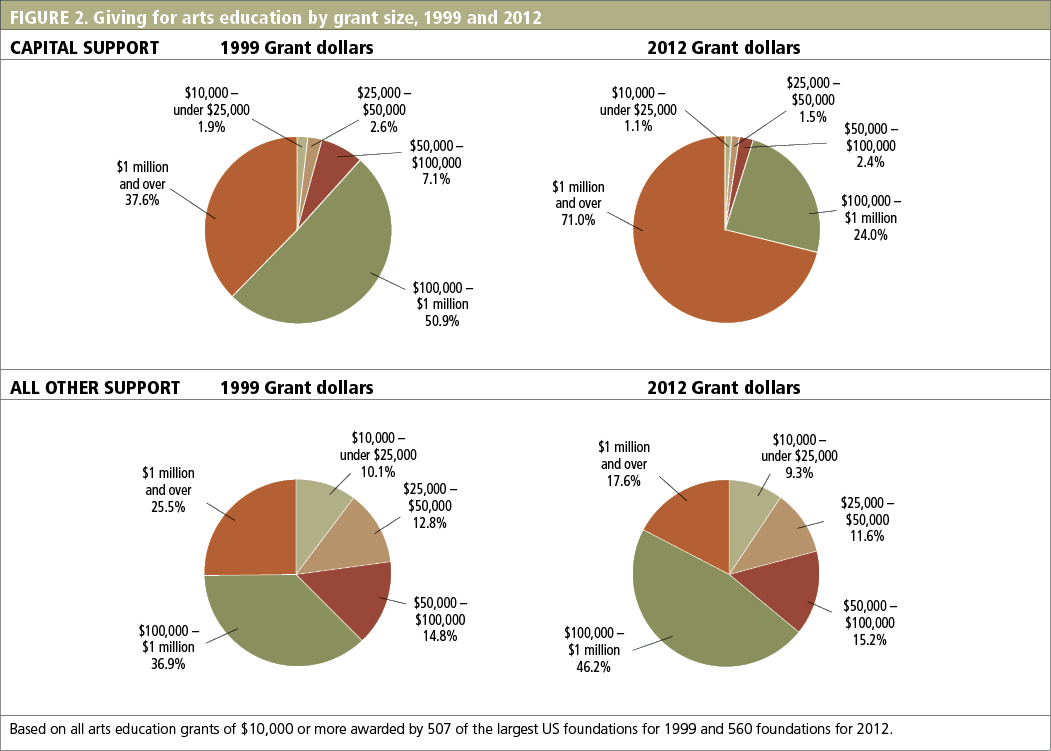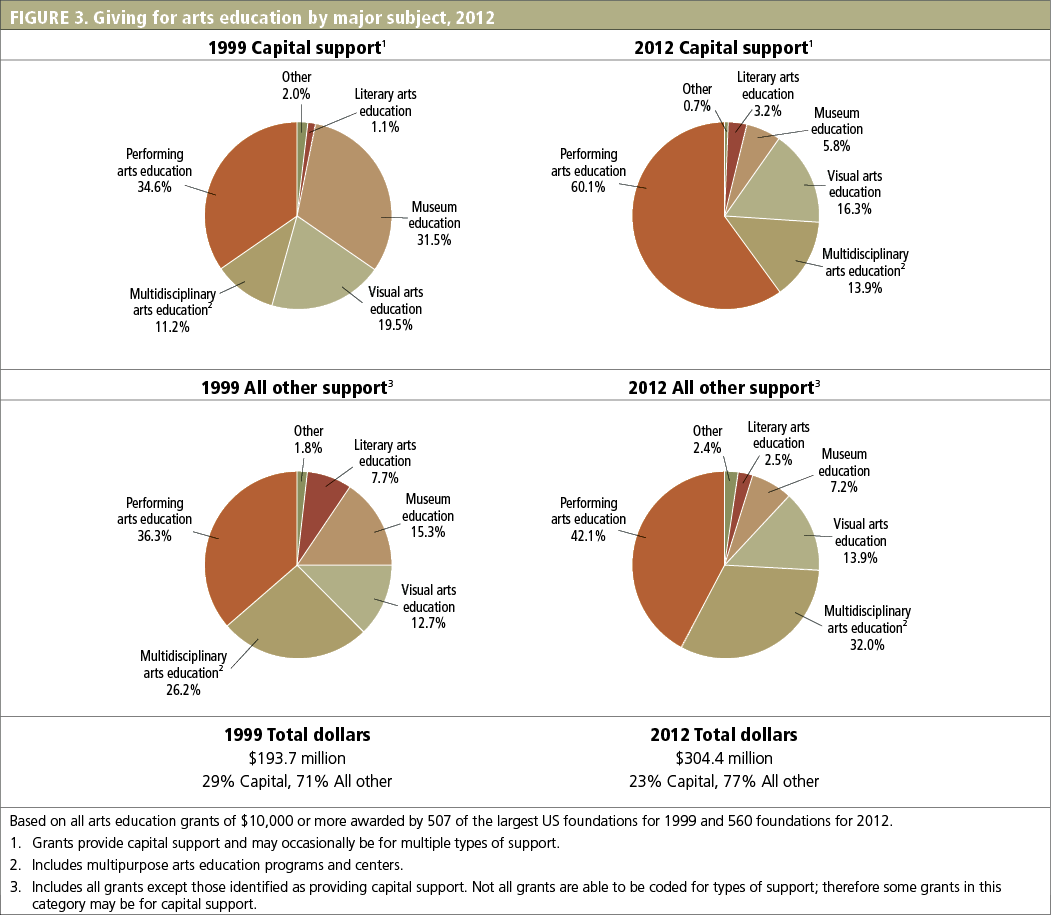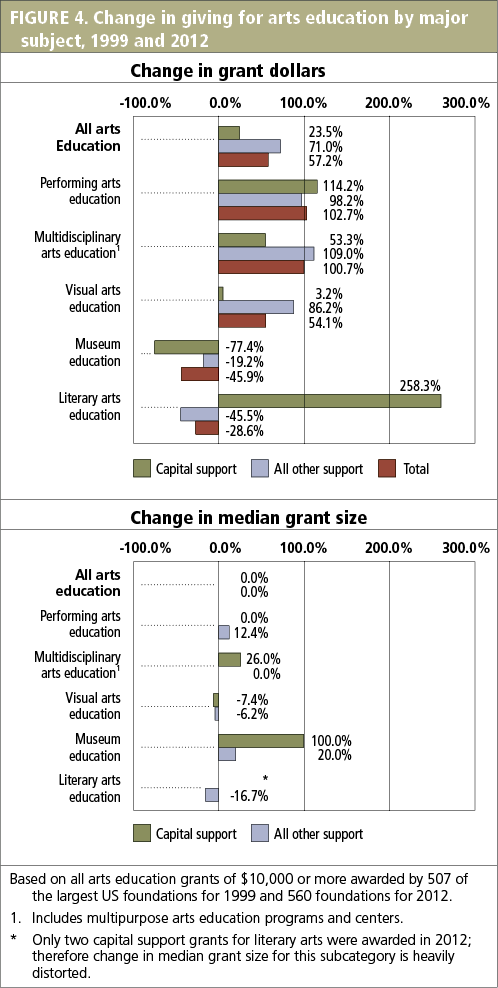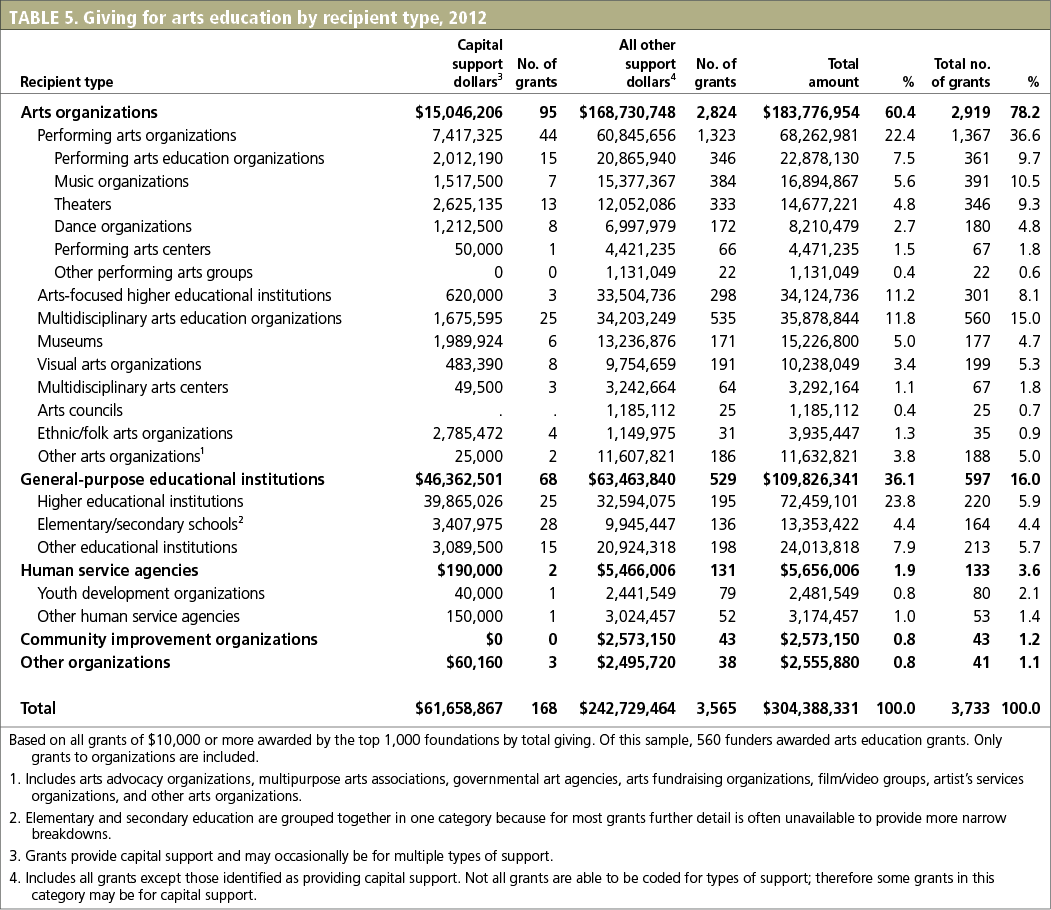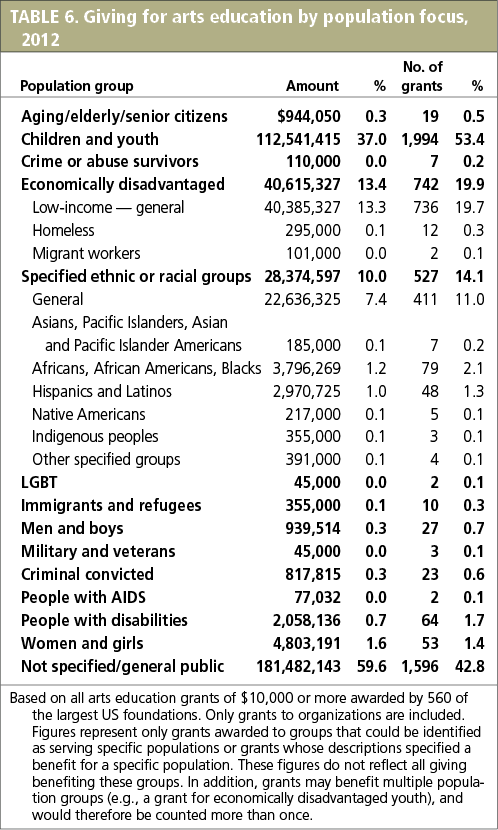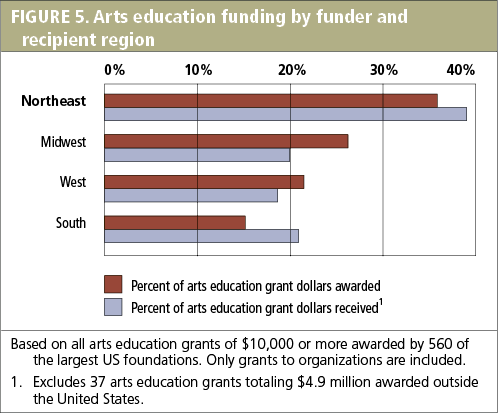Foundation Funding for Arts Education
An Update on Foundation Trends
Download:
![]() Foundation Funding for Arts Education (311 Kb)
Foundation Funding for Arts Education (311 Kb)
Key Findings
- Support for arts education grew 57 percent between 1999 and 2012
- Performing arts education benefited from roughly half of arts education giving
- Arts organizations received three out of five arts education dollars and four out of five arts education grants
- A majority of arts education grants targeted children and youth
Arts education provides the means for sharing beautiful and provocative ideas and images, cultural and political knowledge, and insights about humanity across generations. In a world that grows ever more populous and competitive, arts education also offers a means for nurturing the creative thinking that will ideally lead to better solutions to the world’s many challenges.
To document the size and scope of arts education grantmaking by US foundations, Foundation Center and Grantmakers in the Arts collaborated on a 2005 report, Foundation Funding for Arts Education. The report examined foundation grantmaking for arts education between 1999 and 2003 and represented the most comprehensive analysis of foundation arts education support available. This new report updates the analysis of foundation arts education funding through 2012 and illustrates how support for arts education has evolved during a period of pronounced economic volatility and dramatic political and technological change.
Defining Arts Education Grantmaking
For the purpose of this study, arts education grantmaking has been divided into the major areas of multidisciplinary arts education, performing arts education, visual arts education, museum arts education, and literary arts education and broadly defined as supporting:
- Single-discipline and multidisciplinary arts-in-education and arts and education organizations and programs
- Educational activities and outreach programs of museums, performing arts companies, visual arts centers, and other arts groups
- Development of arts curriculum, arts-related classroom space, and arts and performing arts facilities at schools, colleges, and universities
- Scholarships, fellowships, and residencies for young and emerging artists provided through arts groups and degree-granting arts institutions
- Community arts schools and arts education programs conducted by multipurpose community organizations and youth development groups
- Research on the role and effectiveness of arts education and advocacy to expand and enhance its influence
Trends in Arts Education Funding, 1999 through 2012
Since 1999, this country has experienced an unprecedented economic boom, a stock market downturn and recession, economic recovery, a major economic crisis, and another economic recovery — albeit slow and uneven. Despite these dramatic swings, giving for arts education by funders included in Foundation Center’s annual grants set (see “Sampling Base” for details) rose 57 percent, from $193.7 million in 1999 to $304.4 million in 2012. (Adjusted for inflation, arts education giving rose 14 percent.) This rate of growth was slower than the increase in overall foundation giving recorded during this period but on par with growth in arts funding overall. As a result, arts education’s share of total arts funding remained steady at just over 14 percent. By number of grants awarded, arts education support grew 49 percent during this period, from roughly 2,500 to over 3,700 grants.
While giving for arts education increased between 1999 and 2012, growth was not consistent throughout this period. Arts education grant dollars grew steadily between 1999 and 2005, and this growth accelerated between 2006 and 2008. Grant dollars for the field peaked at $410.2 million in 2008, provided through 4,027 grants. In the first full year of the Great Recession, however, funding for arts education declined 28 percent. It then rebounded slightly in 2010 before slipping an additional 3 percent in 2011. The arts education field returned to strong growth in funding in 2012, when grant dollars increased a robust 18 percent.
The Robina Foundation led all other funders by amount of giving for arts education in 2012, with a single $18 million grant to Yale University to endow the Binger Center for New Theater. If capital grants were excluded, the Andrew W. Mellon Foundation would have ranked as the top arts education funder. The foundation made 34 non-capital arts education grants totaling $14.2 million in 2012, with the majority supporting curriculum and program development. Its overall arts education support totaled $16.3 million.
Among the top 25 arts education funders in 2012, a total of 13 allocated at least 10 percent of their funding for the field. Those directing the largest shares to arts education included the Herb Alpert Foundation (68.2 percent), Robina Founda-tion (68.1 percent), Colburn Foundation (63.1 percent), and Karsh Family Foundation (61.3 percent). By comparison, the second-ranked Mellon Foundation directed 6.4 percent of its total dollars to arts education.
Finally, recently established foundations constituted a growing segment of arts education funders. Overall, the number of arts education funders rose from 507 in 1999 to just over 580 in 2006, before slipping back to 560 in 2012. In the 2012 set, foundations formed since 1995 represented 18 percent of the number of arts education funders in the sample, and these foundations awarded roughly one-quarter of arts education dollars. Foundations established during this period that ranked among top arts education funders included the Robina Foundation (2004), John and Lisa Pritzker Family Fund (2002), Colburn Foundation (1999), Sherwood Foundation (1999), Karsh Family Foundation (1997), and Jack Kent Cooke Foundation (1997).
Arts Education Funding by Grant Size
A substantial share of arts education grants are small. In 2012, over two-fifths (44 percent) of arts education grants were for less than $25,000, compared to just under two-fifths (39 percent) of foundation grants overall. This modestly higher proportion for arts education may reflect a heavier concentration of program grants, which tend to be smaller on average than most other types of support.
By comparison, arts education grants of at least $1 million accounted for just 1 percent of the number of grants awarded but nearly 30 percent of arts education dollars. In 2012, the majority of these large arts education grants provided capital support, and 71 percent of the grant dollars allocated through these big grants funded capital projects. As a result, the average arts education grant ($81,540) was more than three times the size of the median or typical grant ($25,000).
Arts Education Funding by Foundation Type
Independent foundations account for the dominant share of foundation giving for arts education, regardless of the type of support awarded. They provided roughly 93 percent of capital support dollars for arts education in 1999 and 2012. Among arts education funding for other types of support, independent foundations accounted for 83 percent of grant dollars in 1999 and 77 percent in 2012. Still, community foundations played an important role in supporting arts education. While they provided a relatively modest 5 percent of capital support dollars and 12 percent of dollars for all other types of support in 2012, community foundations accounted for close to one-fifth (19 percent) of the number of capital support grants for arts education and one-quarter (24 percent) of the number of all other arts education grants. Similarly, corporate foundations awarded about 9 percent of 2012 arts education grant dollars but over twice that share of grants (19 percent).
Priorities in Arts Education Funding
Performing Arts Education
Overall, performing arts education accounted for roughly half of arts education grant dollars and grants in 2012. Music education constituted the biggest share of performing arts education dollars (34 percent), followed by “Other Performing Arts Education” (27 percent), which includes funding for multidisciplinary performing arts education institutions and programs and theater. A smaller share of funding supported dance education (12 percent). Support for performing arts education more than doubled between 1999 and 2012 — funding rose 103 percent over 1999 (47 percent after inflation) — and growth in this area far exceeded increases in arts education funding overall. Giving was boosted by above-average growth in the number of grants — notably in the areas of dance and theater education. In addition, 5 of the 10 largest arts education grants in 2012 benefited performing arts education, including the largest overall arts education grant: an $18 million capital support grant awarded by the Robina Foundation to Yale University to endow the Binger Center for New Theater.
Among the largest funders of performing arts education were the Robina Foundation (noted above) and the Karsh Family Foundation, which gave $9.1 million through two grants, the majority of which was awarded to Duke University’s Karsh International School for its endowment and the Jazz Loft Project.1 The third-ranked Herb Alpert Foundation provided $3.6 million nationally to performing arts education institutions, followed closely by the Colburn Foundation, which also gave $3.6 million in grants mainly to Los Angeles area–based performing arts institutions. Several foundations targeted arts education programs for underserved or minority youth. For example, the Prudential Foundation awarded $220,000 to the Alvin Ailey Dance Foundation (NY) for AileyCamp Newark and AileyDance Kids Newark, an organization dedicated to using dance to enhance the lives of underserved children.
Multidisciplinary Arts Education
Funding for multidisciplinary arts education, which includes broad arts-in-education centers and programs, multidisciplinary arts schools, and ethnic arts education programs, also doubled between 1999 and 2012. Adjusted for inflation, funding was up 46 percent. The growth in the number of grants also significantly increased during this time (up 72 percent).This area accounted for the second largest share of arts education dollars (28 percent) and grants (28 percent). Within the field of multidisciplinary arts education, support for broad ethnic arts education programs increased eleven-fold.2 Among the larger grants awarded for ethnic arts education in 2012 was a $100,000 grant from the Coca-Cola Foundation to the National Black Arts Festival for its education programs.
The Arkansas-based Windgate Charitable Foundation was the largest funder of multipurpose arts education programs. Windgate awarded $6.6 million across 39 grants, including a $2 million award to the Penland School of Crafts (NC), an international center for craft education; and a $1 million grant to Boston-based North Bennet Street School, a trade and craftsmanship school for new facilities. The second-ranked William and Flora Hewlett Foundation provided $4.5 million, including $1.1 million to the California County Superintendents Educational Services Association for the Reinvigorating Arts Education in California project. Other leading funders of arts-in-the-schools and arts and education programs included the Wallace, A. W. Mellon, Kresge, and Surdna Foundations and the Houston Endowment.
Visual Arts Education
Visual arts education, which includes multipurpose visual arts programs and centers and those with a single focus, such as photography or sculpture, received 14 percent of arts education dollars in 2012. This area accounted for the third largest share of arts education dollars and grants. Several of the biggest visual arts education grants provided capital support — including the largest grant, a $5.6 million award by the Donald W. Reynolds Foundation to the University of Arkansas for the construction of the Steven l. Anderson Design Center. Many of the grants were awarded to colleges and universities for fine arts programs, to museums exclusively for visual arts education programming, and to visual arts education organizations benefiting children and youth. In the latter category, the Ford Foundation awarded a $446,529 grant to the Jakarta-based Kampung Halaman Foundation for the work of a national youth-led network to produce multimedia digital content, conduct online media campaigns, and strengthen youth leadership in local decision-making processes; the Surdna Foundation awarded $270,000 to the Maryland Institute College of Art for mentoring, support, and financial aid to high school students and visual art teachers engaged in intensive, summer residency studio art experiences that will increase skills for both college preparedness, teacher quality, and impact; and the James Irvine Foundation provided $185,000 to Big Draw LA, to hold a series of participatory public drawing events at traditional and nontraditional venues and to develop a mobile device application to engage younger audiences in creating and sharing their drawings. Also included in this subfield were grants to visual arts schools for tuition aid for young visual artists.
Museum Arts Education
Funding for broad-based museum arts education declined between 1999 and 2012, and its share of arts education dollars fell from 20 percent to 6.9 percent. Contributing to this reduction were the two top museum arts funders in 1999: the Robert W. Woodruff and Ewing Marion Kauffman Foundations. The Woodruff Foundation reported substantially lower levels of giving for this purpose, while the Kauffman Foundation did not award any grants for this area in 2012. The share of number of grants also decreased, from 8.6 percent to 4.6 percent. The majority of support targeted general education activities, facilities, and resources of art museums. Grants also supported educational programs of general purpose, children’s, ethnic/folk arts, history, and specialized museums.3 Similar to other fields of arts education funding, a few of the very largest museum grants supported capital projects, such as the Champlin Foundations’ $250,000 grant to the Rhode Island School of Design to complete the Radeke building restoration project at the Museum of Art. Nevertheless, the vast majority of grant dollars and grants for museum arts education supported programming, including school-based programs. For example, 2012 grants included $150,000 in support from the Claude Worthington Benedum Foundation to the Children’s Museum of Pittsburgh to establish hands-on learning laboratories in museums, libraries, and classrooms in West Virginia and southwestern Pennsylvania; and PNC Foundation’s $100,000 grant for the Fernbank Museum of Natural History (GA) for a collaboration with the Robert Woodruff Arts Center (Young Audiences Woodruff) and Sheltering Arms Early Education and Family Center.
Literary Arts Education
Funding for literary arts education accounted for 2.6 percent of arts education support in 2012, down slightly from the 3.1 percent share in 1999. Nonetheless, the number of grants awarded increased from 78 to 96 grants. Since even the largest funders of literary arts education reported, on average, 2 or fewer grants, this finding reflects an increase in the number of funders making grants. Within this subfield, the types of programs supported ranged from undergraduate and graduate literature programs to school- and community-based programs in poetry, literature, reading, and creative writing. Among the larger grants awarded for this area was a $896,000 award from the Andrew W. Mellon Foundation to Book Arts Press (VA) for the Andrew W. Mellon Fellowship of Scholars in Critical Bibliography; a $250,000 award from the Zell Family Foundation to the University of Michigan for the MFA Creative Writing program; and the Brown Foundation’s $80,000 grant to Writers in the Schools (TX) for in-school creative writing workshops and artist visits.
Arts Education Funding by Recipient Type
Arts education giving overwhelmingly targets arts organizations, with entities that focus exclusively on multidisciplinary arts education, postsecondary arts education, and performing arts education capturing the largest shares of support. In 2012, just over three-fifths of arts education grant dollars and nearly four-fifths of grants supported arts organizations. Multidisciplinary arts education organizations — e.g., the Harlem School of the Arts (NY) and the Center for Arts-Inspired Learning (OH) — accounted for the largest share of funding (12 percent) among arts organizations. Following these organizations by share of grant dollars were arts-focused higher and graduate educational institutions (11 percent) — e.g., the Juilliard School (NY) and Berklee College of Music (MA) — and performing arts education organizations (8 percent) — e.g., the Colburn School of the Performing Arts (CA) and Lincoln Center Institute (NY). Other arts organizations receiving at least 5 percent of arts education giving in 2012 included music organizations and museums.
Arts education giving in the latest year also heavily focused on general purpose higher and graduate educational institutions and elementary and secondary schools. Together, these institutions accounted for 36 percent of 2012 grant dollars and 16 percent of grants. The majority of this support targeted arts programs of higher and graduate educational institutions, including several exceptionally large capital and general operating support grants. By comparison, elementary and secondary schools received less than 5 percent of total arts education grant dollars. In general, this finding reflects the disinclination of most grantmakers to provide funding to public elementary and secondary schools directly.
Finally, the number of organizations in the sample benefiting from arts education support jumped nearly 30 percent between 1999 and 2012, from just over 1,500 to more than 1,950. Nonetheless, the average number of grants received by organizations in 2012 — 2 grants — was unchanged from 1999. Some institutions, however, received far more grants. At the top of the list, the Kansas City Ballet Association received 28 grants, followed by the Juilliard School (21) and Children’s Theater Company and School (20).
Arts Education Funding for Specific Populations
Within their arts education giving, some foundations direct support to vulnerable or underserved populations, such as to specific ethnic or racial groups or communities of color in general and to the economically disadvantaged. This giving targets both subsets of children and youth — the predominant beneficiaries of arts education support — and others.
For example, the W. K. Kellogg Foundation made a $352,000 grant to Living Arts (MI) to improve literacy, academic outcomes, and school attendance for vulnerable children by providing support for the training of parents and teachers in arts-infused methodology, and making essential arts experiences available in the Vistas Nuevas Head Start Centers and schools of Southwest Detroit; and the James Irvine Foundation provided a $90,000 grant to Eastside Arts Alliance (CA) to develop a mural park, providing opportunities for low-income, Latino youth from East Oakland to create graffiti art murals.
Arts Education Funding by Funder and Recipient Region
Foundations in the Northeast provided the largest share of arts education funding in 2012 (36.3 percent), led by funders based in New York and Pennsylvania. Three of the top 10 arts education funders were located in the Northeast—the second-ranked Andrew W. Mellon Foundation (NY), sixth-ranked Wallace Foundation (NY), and ninth-ranked PNC Foundation (PA). The Midwest accounted for the second largest share of arts education grant dollars awarded (26.6 percent), followed be the West (21.7 percent) and the South (15.3 percent).
Given that the Northeast is home to many of the largest arts education funders and prominent arts education institutions, it is not surprising that organizations in the region received the largest share of grant dollars (39.4 percent). Five of the top 10 recipients of arts education giving were based in the Northeast, led by Yale University, which received $20.8 million.4 Following the Northeast by share of grant dollars received were organizations in the South (21.3 percent), Midwest (20.3 percent), and West (18.9 percent).
Nearly all arts education grant dollars supported domestic programs. Just 2.3 percent targeted cross-border recipients in 2012, while roughly 4.5 percent funded US-based international arts programs.
Identifying Arts Education Grants
Consistent with the definition of arts education funding employed for this report (see “Defining Arts Education Grantmaking”), this analysis includes all grants with a primary or secondary grant purpose or recipient type code for arts education or performing arts education; a primary grant purpose code for multidisciplinary arts, folk arts, arts councils, visual arts, art museums, ethnic/folk art museums, children’s museums, performing arts, literary services, and arts and artist’s service activities and a secondary grant purpose code for education (excluding libraries); and a primary grant purpose code of education (excluding libraries), camps, and youth development and a secondary grant purpose code for multidisciplinary arts, folk arts, arts councils, visual arts, art museums, ethnic/folk art museums, children’s museums, performing arts, literary services, and arts and artist’s service activities.
Looking Ahead
Nearly a decade has passed since Foundation Center and Grantmakers in the Arts first studied foundation funding for arts education. That earlier examination noted that several newer foundations were showing an interest in arts education, which boded well for the field, and also that “Foundations have served as key proponents and supporters of arts education, and that role will likely expand in the years ahead.” Both predictions held true as arts education funding remained largely stable during a period markedly more volatile than was true of the preceding decades.
What comes next for arts education funding? Certainly, economic prospects appear healthier than in recent years, suggesting the potential for growth in overall arts education grantmaking. More critical to the future of the field, however, may well be the work of current arts education funders in continuing to engage a new generation of donors. The contributions of arts education to a creative and prosperous society are well documented. But these learnings may need to be translated in a way that engages donors who want to be more hands-on, see their priority as addressing specific populations, and may not immediately connect with how support for arts education can facilitate those goals. Arts education is a powerful resource for ensuring greater equity in society, and funders need only find the most resonant ways to make this case.
- Capital support accounted for 23 percent of arts education giving in 2012 and was relatively evenly distributed among the major arts education fields. For example, performing arts education represented approximately 46 percent of overall grant dollars in the latest sample and 42 percent when capital support was excluded.
- Not all grants related to ethnic arts education are captured in the multidisciplinary arts education subfield. For example, some of these grants were included in visual arts and in performing arts education.
- Grants for science museum education programs were excluded from this analysis.
- If capital grants were excluded, Yale University’s arts education support would decrease to $2.8 million.
Sampling Base
The information presented in this report is based on Foundation Center’s annual grants sets. Each set includes all of the grants of $10,000 or more awarded to organizations by 1,000 of the largest US foundations by total giving and represents roughly half of total grant dollars awarded by the universe of independent, corporate, community, and grantmaking operating foundations in that year. Specifically, the 2012 grants set included 153,821 grants totaling $22.4 billion; and the 1999 set included 81,112 grants totaling $8.6 billion. Grants to individuals and grants from donor-designated and restricted funds of community foundations are not included.
In-School and Out-of-School
In this report, Foundation Center did not differentiate between in-school and out-of-school programs.
Capital Support and All Other Support
For the purpose of this report, grants have been separated into capital (buildings/facilities) and all other types of support (programmatic/administration/etc.).


